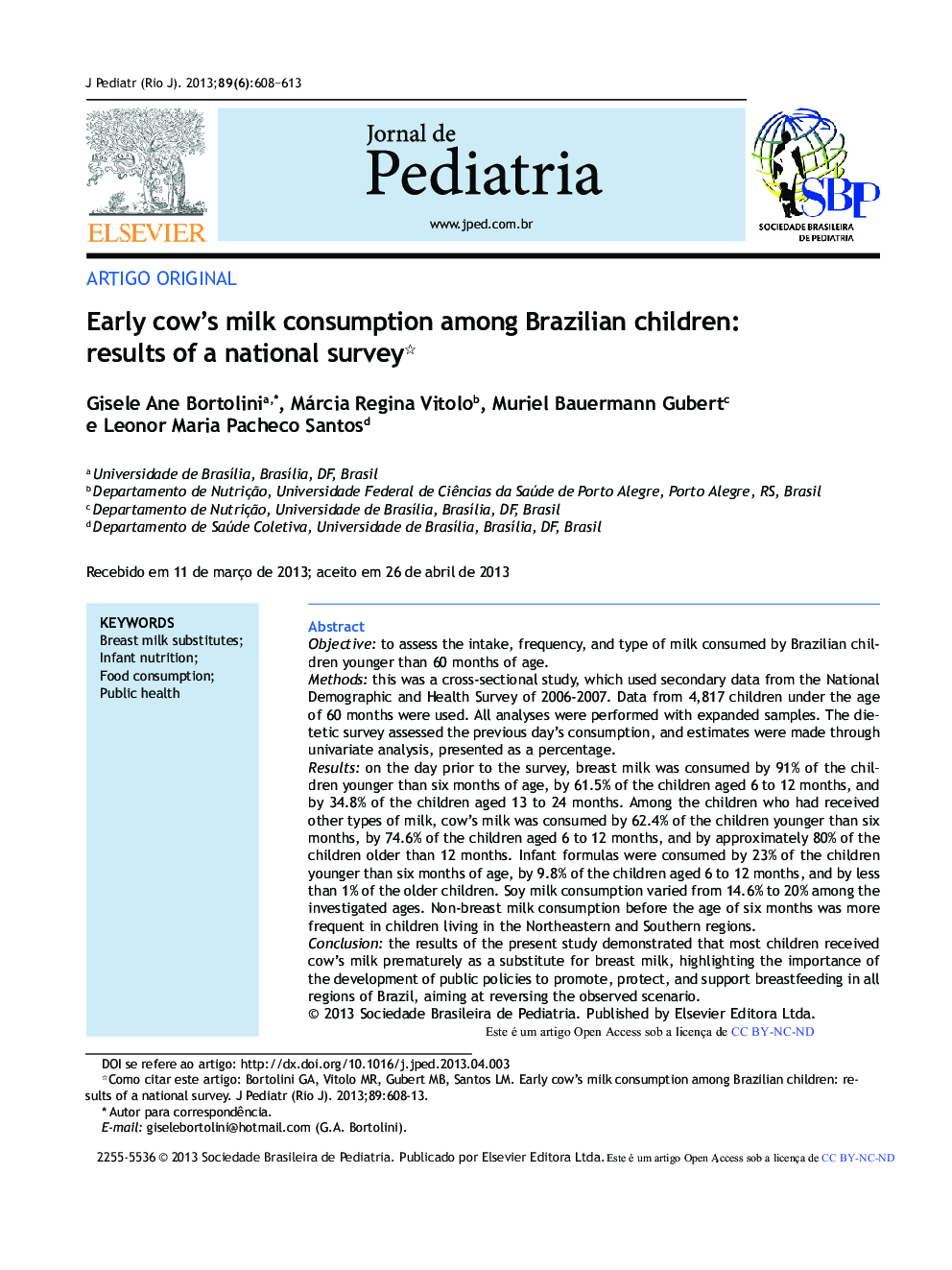| Article ID | Journal | Published Year | Pages | File Type |
|---|---|---|---|---|
| 4154638 | Jornal de Pediatria (Versão em Português) | 2013 | 6 Pages |
Objectiveto assess the intake, frequency, and type of milk consumed by Brazilian children younger than 60 months of age.Methodsthis was a cross-sectional study, which used secondary data from the National Demographic and Health Survey of 2006-2007. Data from 4,817 children under the age of 60 months were used. All analyses were performed with expanded samples. The dietetic survey assessed the previous day's consumption, and estimates were made through univariate analysis, presented as a percentage.Resultson the day prior to the survey, breast milk was consumed by 91% of the children younger than six months of age, by 61.5% of the children aged 6 to 12 months, and by 34.8% of the children aged 13 to 24 months. Among the children who had received other types of milk, cow's milk was consumed by 62.4% of the children younger than six months, by 74.6% of the children aged 6 to 12 months, and by approximately 80% of the children older than 12 months. Infant formulas were consumed by 23% of the children younger than six months of age, by 9.8% of the children aged 6 to 12 months, and by less than 1% of the older children. Soy milk consumption varied from 14.6% to 20% among the investigated ages. Non-breast milk consumption before the age of six months was more frequent in children living in the Northeastern and Southern regions.Conclusionthe results of the present study demonstrated that most children received cow's milk prematurely as a substitute for breast milk, highlighting the importance of the development of public policies to promote, protect, and support breastfeeding in all regions of Brazil, aiming at reversing the observed scenario.
ResumoObjetivoavaliar o consumo, frequência e tipo de leite ingerido por crianças brasileiras menores de 60 meses.Métodosestudo transversal baseado em dados secundários da Pesquisa Nacional de Demografia e Saúde de 2006/7. Foram utilizados dados de 4.718 crianças menores de 60 meses. Todas as análises foram realizadas com amostra expandida. O inquérito dietético representou o consumo do dia anterior e foi estimado por meio de análise univariada apresentada em percentual.Resultadosconsumiram leite materno no dia anterior à investigação 91% das crianças menores de seis meses e 34,8% das crianças de 13 a 24 meses. Entre as crianças que receberam outros leites, o leite de vaca foi consumido por 62,4% das crianças menores de seis meses, por 74,6% das crianças de 6 a 12 meses e por aproximadamente 80% das crianças maiores de doze meses. O consumo de fórmulas infantis foi de 23% em crianças menores de seis meses, 9,8% na idade de 6 a 12 meses e menor 1% nas demais idades. O consumo de leite de soja variou de 14,6% a 20% nas idades investigadas. O consumo de leite não materno antes de seis meses de idade foi mais frequente em crianças residentes nas Regiões Nordeste e Sul.Conclusãoos resultados deste estudo mostram que a maior parte das crianças recebeu leite de vaca em substituição ao leite materno. Enfatiza-se a importância do fomento às políticas públicas de promoção, proteção e apoio ao Aleitamento Materno em todas as regiões brasileiras para reversão do cenário observado.
